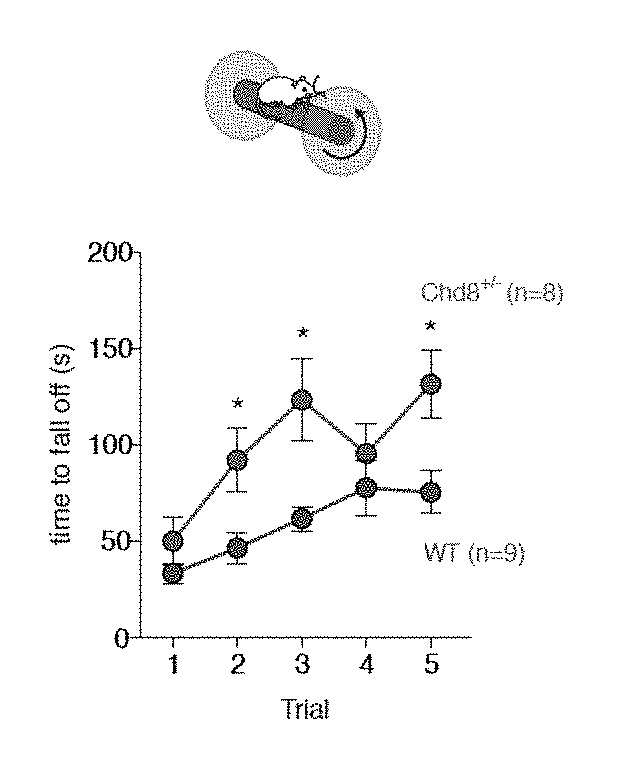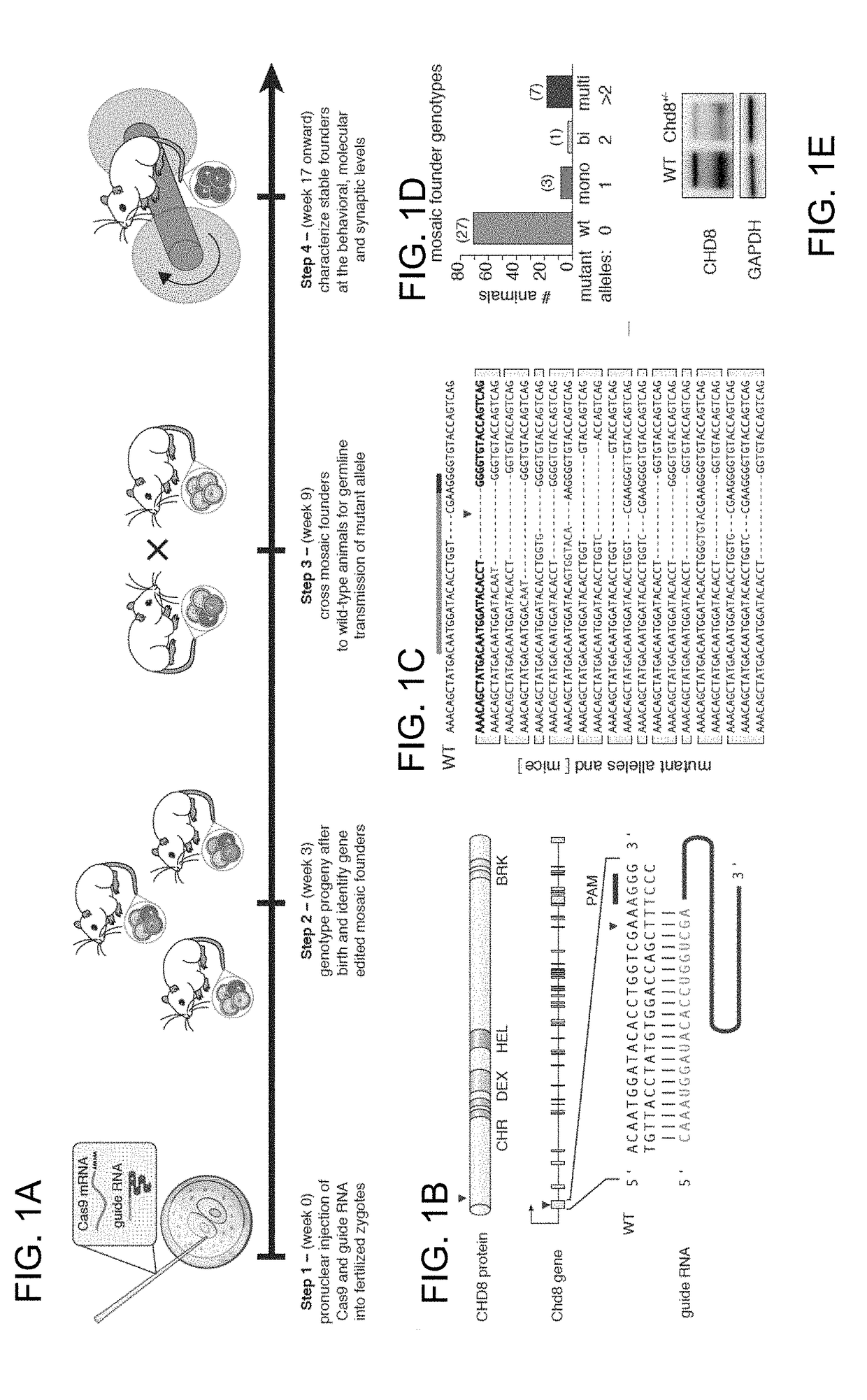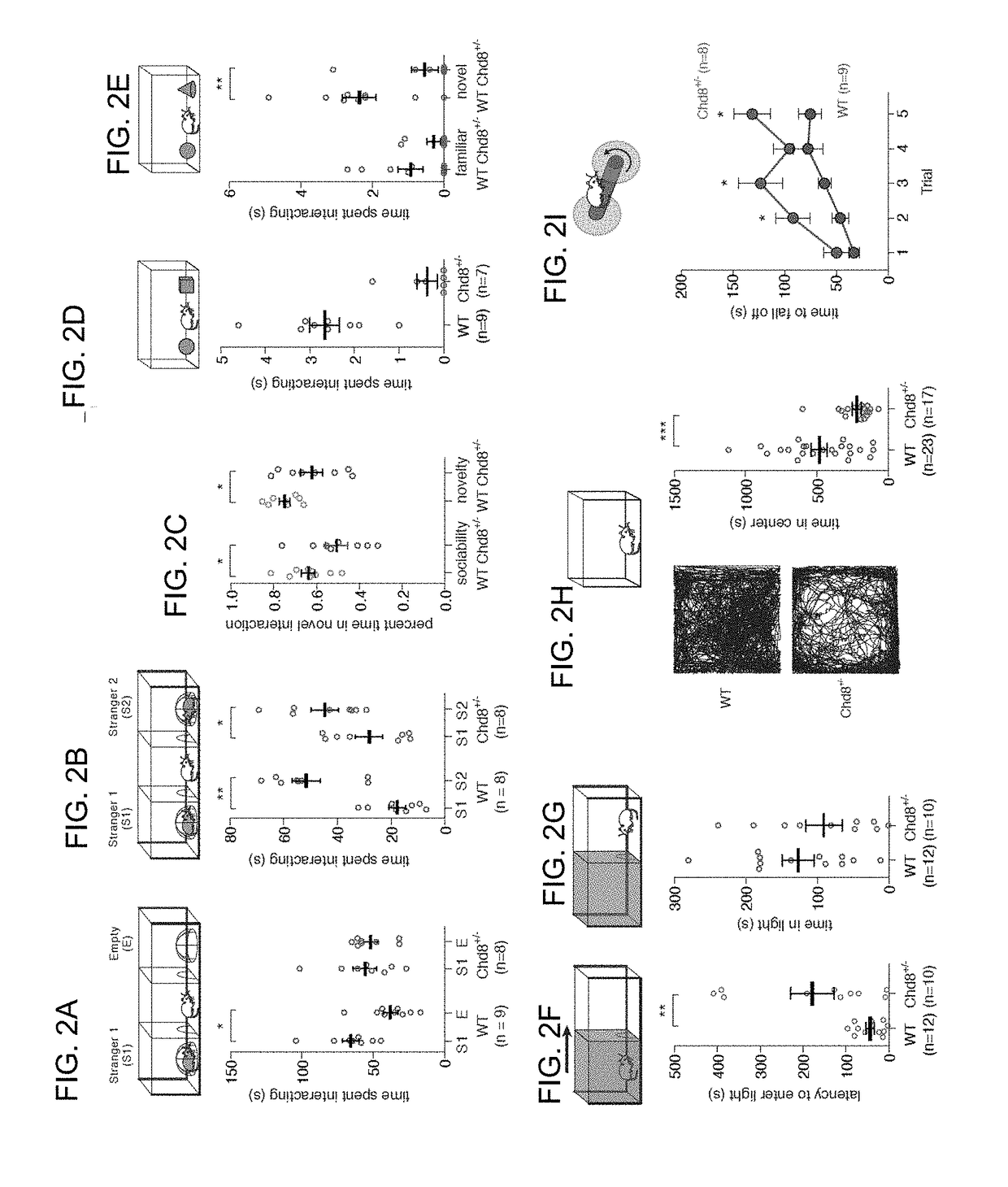Use and production of chd8+/- transgenic animals with behavioral phenotypes characteristic of autism spectrum disorder
a technology of autism spectrum disorder and transgenic animals, which is applied in the field of use and production of chd8 +/transgenic animals with behavioral phenotypes characteristic of autism spectrum disorder, can solve the problems that the function of chd8 in neural cell lineages has been largely unexplored, and achieve the effect of rapid mouse model developmen
- Summary
- Abstract
- Description
- Claims
- Application Information
AI Technical Summary
Benefits of technology
Problems solved by technology
Method used
Image
Examples
example 1
A Cre-Dependent CRISPR-Cas9 Knockin Transgenic Mouse for Efficient Ex Vivo and In Vivo Genome Editing
[0180]Reference is made to WO 2014 / 093622 (PCT / US13 / 74667), incorporated herein by reference.
[0181]CRISPR-Cas9 is a powerful technology for genome editing and is being widely adopted due to its efficiency and versatility. While Cas9-mediated genome editing applications are compelling, applying them in vivo and ex vivo is challenging, since commonly used delivery systems are inefficient and limit accessible cell types. To broaden the application of Cas9 Applicants established a Cre-dependent, Rosa26 Streptococcus pyogenes Cas9 knockin mouse and demonstrate its utility in diverse applications, which include gene editing in vivo in the brain by AAV-mediated delivery of an sgRNA expression cassettes and in vivo in endothelial cells by nanoparticle-mediated sgRNA delivery. Applicants also demonstrate efficient editing of key regulators ex vivo in hard to transfect / transduce primary immune...
example 2
Animal Models
[0205]Transgenic animals are also provided. Preferred examples include animals comprising Cas9, in terms of polynucleotides encoding Cas9 or the protein itself. Dogs, mice, pigs, rats, rabbits, sheep and non-human primates re preferred. To generate transgenic mice with the constructs, as exemplified herein one may inject pure, linear DNA into the pronucleus of a zygote from a pseudo pregnant female, e.g. a CB56 female. Founders may then be identified, genotyped, and backcrossed to CB57 mice. The constructs may then be cloned and optionally verified, for instance by Sanger sequencing. Knock outs are envisaged where for instance one or more genes are knocked out in a model. However, knockins are also envisaged (alone or in combination), with Cas9 knockins as preferred. To generate a Cas9 knock in mice one may target the same constitutive and conditional constructs to the Rosa26 locus. Animal models envisioning both inducible and constitutive Cas9 expression are contemplat...
example 3
Mutations
[0212]As used herein, the terms “neuronal,”“neurological,”“nervous system-related” are used interchangeably and intended to have the same meaning. With respect to diseases and / or disorders or conditions of neuronal / neurological / nervous-system related, the present invention relates to targeting genes and mutants thereof in, for example in, but not limited to, genes involved in, associated with or correlated with, autism, autism spectrum disorders (ASDs), psychiatric / neuropsychiatric diseases or disorders, obsessive compulsive disorders (OCD), Rett syndrome, schizophrenia, Huntington's disease, etc. In this regard, mention is made of the following exemplary publications which discuss certain aspects of such diseases or disorders, the text of each of which publication is incorporated herein in its entirety for all purposes.
[0213]Peça J. et al. Shank3 mutant mice display autistic-like behaviors and striatal dysfunction. Nature 2011 Apr. 28;472(7344):437-42. doi: 10.1038 / nature0...
PUM
| Property | Measurement | Unit |
|---|---|---|
| weight | aaaaa | aaaaa |
| total volume | aaaaa | aaaaa |
| size | aaaaa | aaaaa |
Abstract
Description
Claims
Application Information
 Login to View More
Login to View More - R&D
- Intellectual Property
- Life Sciences
- Materials
- Tech Scout
- Unparalleled Data Quality
- Higher Quality Content
- 60% Fewer Hallucinations
Browse by: Latest US Patents, China's latest patents, Technical Efficacy Thesaurus, Application Domain, Technology Topic, Popular Technical Reports.
© 2025 PatSnap. All rights reserved.Legal|Privacy policy|Modern Slavery Act Transparency Statement|Sitemap|About US| Contact US: help@patsnap.com



